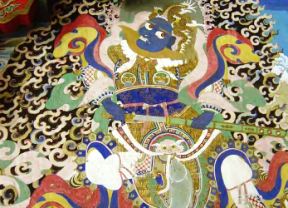Located 40 km north of Zhada County, Donggar Frescos are the largest ruins of the ancient Buddhist frescos.
It is about 40 km northwest to the Guge Ruins, Donggar is a small village of 10-odd households. Donggar Frescos are  scattered in the grottos on the bluff north to the village. There are about 200 grottoes now, which spread 2 km and look like the honeycombs. Several of the grottoes with fine frescos cluster on the eastern U-shape crag. scattered in the grottos on the bluff north to the village. There are about 200 grottoes now, which spread 2 km and look like the honeycombs. Several of the grottoes with fine frescos cluster on the eastern U-shape crag.
Donggar Frescos, which cluster in the 3 grottos half way up the mountain, are preserved well. It is not recorded in the Tibetan historic, religious or cultural dossiers when or how these frescos were painted. But scientists are sure that the frescos have a history of about 1,000 years and the discovery of them is significant in the field of archeology.
The frescos are mainly paintings of figures of Buddha and Bodhisattva, Buddhist stories, various vignettes and so forth. The figures of heavenly maids are especially vivid in the frescos.
Special mineral pigments were used for the frescos, and the color hasn’t faded even after hundreds of years.
|
